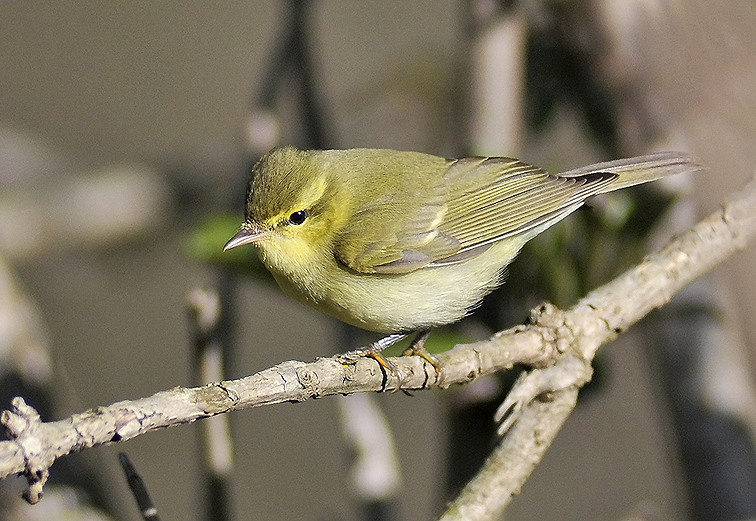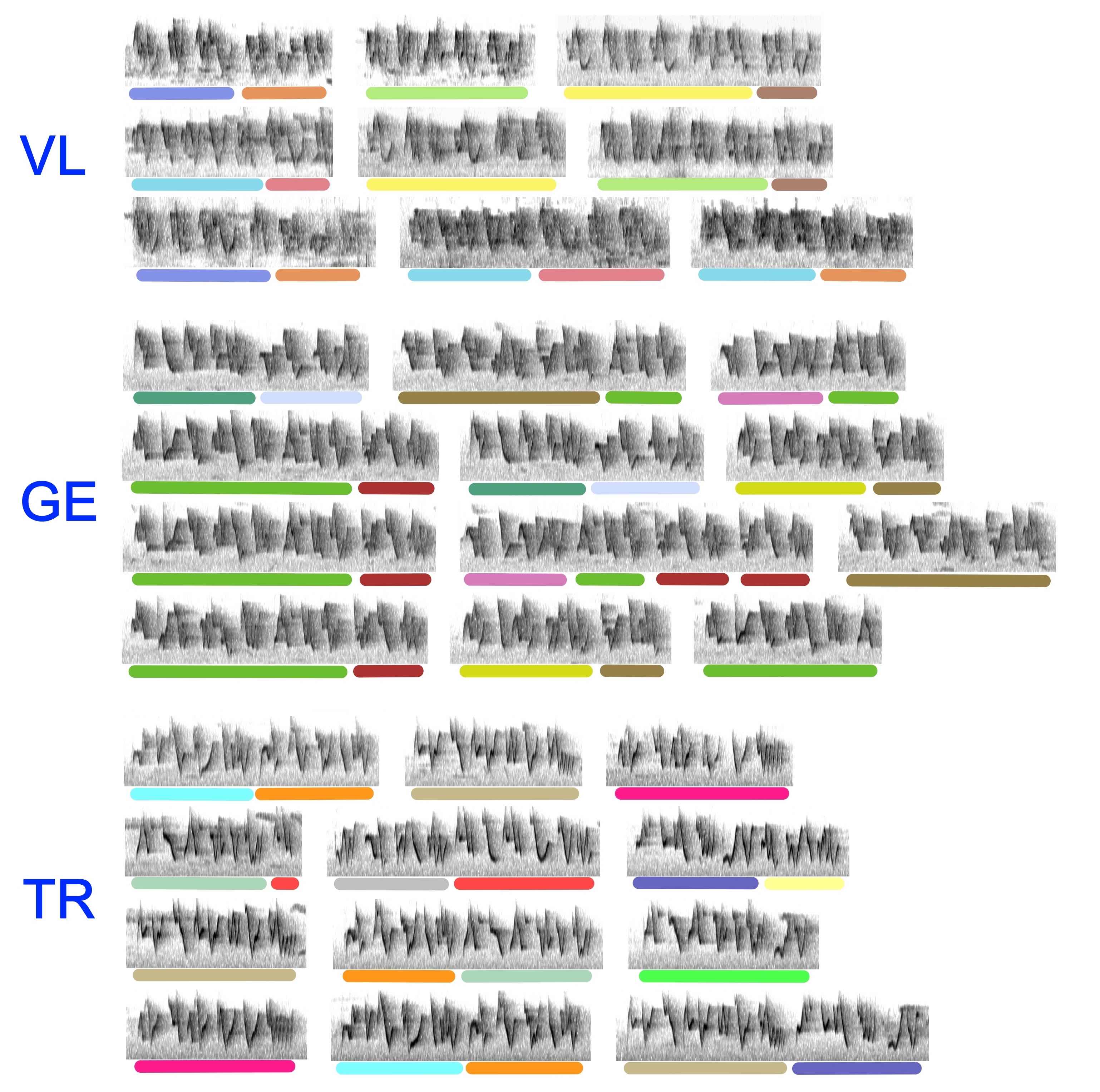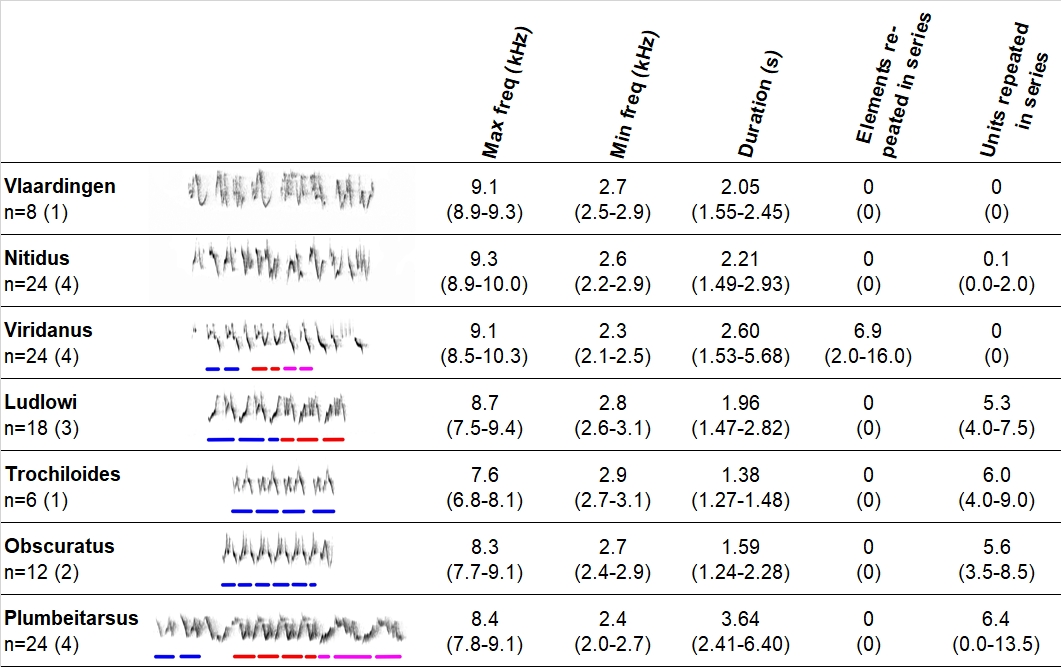Song and call identification of the first Green Warbler for the Netherlands

Green Warbler Phylloscopus nitidus Kiliaan, Tavush, Armenia, 3 May 2011 (René Pop)
On Monday 24 June 2019 around 12:30, I returned to my home in the Netherlands after a pleasant morning of fieldwork near Lochem, Gelderland. While my son Julian – just home from school – was eating a sandwich, I was checking websites for interesting bird reports, like I do every day. Most notable was a Greenish Warbler Phylloscopus trochiloides discovered on this hot summer day by Francien Domenie in an urban park at Vlaardingen, Zuid-Holland. Casually, I played a sound-recording of the bird made by Karel Hoogteyling and then it all happened… My heart skipped a beat and I got a lump in my throat. The calls did not sound right for Greenish Warbler and the song was odd too! I had studied calls of Green Warbler P nitidus before and in my memory these ones sounded identical. The only problem: Green Warbler is a mega rarity in north-western Europe with, thus far, zero records in the Netherlands. I got a bit shaky…
I listened to the sound-recording a few more times and decided to contact Karel. I asked him if he had been able to see the bird and notice anything strange about it. When I told him that I suspected it to be a Green Warbler, I think Karel got a bit shaky too… It was time to send out a Dutch Bird Alert to inform the rest of the birding community before trying to see the bird myself. With high hopes I travelled to Vlaardingen and, apparently, I was not the only one. A total of c 40 birders searched for the bird until darkness fell, but unfortunately it was nowhere to be found. It turned out that just eight local birders had seen it that morning, before it disappeared around 11:00.
Description
The bird had been behaving like a typical Phylloscopus warbler, nervously moving and singing high up in the trees. It was much easier to hear than to see. Initially, the bird was identified as a Greenish Warbler based on its song. Features of its plumage seemed to justify this; several observers noted for example a prominent supercilium and a wing bar (formed by pale tips to the greater coverts). Two observers also saw a yellowish tinge on the breast, an important feature for Green Warbler. These sightings were only brief and not enough to let the alarm bells ring.
The bird was not photographed; three poor photographs posted online seem to show a Common Chiffchaff P collybita, of which a few individuals were present in the same area.
Identification
My identification as a Green Warbler is based on the sound-recordings of song and call made that morning by Francien Domenie and Karel Hoogteyling. Plumage features support this, and the yellowish tinge on the breast can be seen as a confirmation.
Characteristic of Green Warbler are:
1) A rather complex cheeluee call, which in sonagrams looks w-shaped. The difference from Greenish Warbler, a species that turns up annually in the Netherlands nowadays (P t viridanus), is quite easy to hear; viridanus has shorter, hurried, ‘up-down’ calls (chwee-oo, n-shaped sonagram).

Calls of the Vlaardingen warbler (Karel Hoogteyling)
2) Fairly short song phrases, which are not preceded by an introductory note and are built up out of rather complex elements (many V- or W-shaped). The first element often returns within the same song phrase; however, prominent repetitions are lacking. Songs of viridanus normally start with a short introductory note that is followed by a fast series of mostly descending elements. Single elements are often repeated in series a few times and songs are broken up into sections, more or less as in Common Chaffinch Fringilla coelebs.




Songs of the Vlaardingen warbler (Francien Domenie)
Greenish Warbler complex
The Greenish Warbler complex is a very interesting one and has been well studied, more than once before. It is often cited as an example of a ‘ring species’; the group has its roots in the Himalayas, from where populations spread both eastward and westward around the Tibetan Plateau. For an overview of the variation in song and call, Irwin (2000) and Irwin et al (2008) are very useful sources. Hereafter, I will discuss the various taxa and illustrate the most important differences with sonagrams; for a good comparison I have made them on the same scale as those of the Vlaardingen warbler above (0-9 kHz, 0-3.5 sec). The focus is on how to separate Green Warbler from the other taxa. Sound-recordings of all taxa within the Greenish Warbler complex can be found on the internet, even if there are only a few. With the help of several people (see acknowledgements) I was able to collect enough recordings to get a clear picture of Green Warbler and of the most important differences from the other taxa.
Plumbeitarsus
Calls of the Vlaardingen warbler could be confused with those of plumbeitarsus (Two-barred Warbler). Songs of this East-Asian taxon, however, are clearly different. Its song phrases are usually fairly long and melodious, often with a swelling and undulating character, and with song elements that succeed each other at a high pace. Another striking feature is that phrases are usually built up out of fixed combinations of elements (‘song units’). Often, these units are repeated in series a few times within a phrase. There are numerous variants, including phrases consisting for a large part of just one very long song unit. However, the previously mentioned characters are still conspicuous (see for example descriptions in Irwin (2000) and Kovylov et al (2012)).

Calls of plumbeitarsus, Teplie Ozera, Irkutsk, Russia, 20 June 2019 (Stanislas Wroza, XC485950). Plumbeitarsus has on average somewhat more complex and lower-pitched calls than nitidus.

Song of plumbeitarsus, Teplie Ozera, Irkutsk, Russia, 20 June 2019 (Stanislas Wroza, XC485945). Plumbeitarsus uses complex song units, often repeated in series a few times. Phrases have an undulating character (also visible in this example) and last long (often much longer than here). Also incomplete units are frequently used (lowercase ‘a’ in this example).

Song of plumbeitarsus, Irkutsk, Russia, 18 June 2019 (Stanislas Wroza, XC486548). Example of a very long song unit, covering almost the whole song.
Obscuratus
This taxon – ‘intermediate’ between plumbeitarsus and nominate trochiloides – has its breeding range in central China and has never been recorded in Europe. Its song is clearly different from the Vlaardingen warbler, consisting of a simple repetition of one or two rather complex song units. Obscuratus is quite similar to nominate trochiloides and ludlowi in this respect (Irwin 2000).

Calls of obscuratus, Beishan National Forest Park, Qinghai, China, 6 July 2019 (Peter Boesman, XC491446)

Song of obscuratus, Laoye Shan, Qinghai, China, 31 May 1993 (Per Alström)
Nominate trochiloides
This taxon breeds in the central and eastern Himalayas and has never been recorded in Europe. Its songs, in particular, are very different from those of the Vlaardingen warbler. They normally repeat just one rather complex song unit, often at a high pace and within a small frequency range (Irwin 2000).

Call of nominate trochiloides, Paro, Bhutan, 9 June 2018 (Jens Kirkeby, XC420982). See here for a similar example from Sikkim, India: https://macaulaylibrary.org/asset/173527#_ga=2.20994747.1219016689.1572618648-1101395980.1572347978

Song of nominate trochiloides, Paro, Bhutan, 9 June 2018 (Jens Kirkeby, XC420982)
Ludlowi
This taxon – ‘intermediate’ between nominate trochiloides and viridanus – breeds in the western Himalayas and has never been recorded in Europe. Both calls and songs are clearly different from those of the Vlaardingen warbler. The use of repeated song units is typical also for this taxon (Irwin 2000).

Calls of ludlowi, Killar, Himachal Pradesh, India, 7 July 2016 (Pratap Singh). These resemble calls of viridanus, with its descending final part. Recordings from elsewhere within ludlowi’s range are very similar, for example this one from Kashmir, India. Irwin et al (2008) also gives an example more closely resembling nominate trochiloides; that recording was made at Manali, Himachal Pradesh, India – a bit more to the south-east and closer to the range of nominate trochiloides.

Song of ludlowi, Killar, Himachal Pradesh, India, 9 July 2016 (Pratap Singh). The structure is typical: a simple repetition of one or a few song units. Ludlowi is very similar to nominate trochiloides and obscuratusin this respect. See here for a similar example of ludlowi from Kashmir, India.
Viridanus
Viridanus has a rather large breeding range, extending all the way to north-western Europe. Both calls and songs are clearly different from those of the Vlaardingen warbler. In the entire range of virididanus, the commonest call-type is characterised by a descending final part. This is confirmed by Irwin et al (2008) and by many sound-recordings on the internet.

Calls of viridanus, Chokpak station, Kazakhstan, 12 May 2000 (Magnus Robb)
Song of viridanus clearly differs from the taxa discussed above and from nitidus. Typical song phrases start with a short introductory note, followed by a fast series of mostly descending elements. Single elements are often repeated in series a few times and songs are broken up into distinct sections. Repetitions of song units within the same phrase are rare.

Song of viridanus, Örskär, Uppland, Sweden, 16 June 2012 (Jelmer Poelstra, XC108559). Typical are the introductory note (I), many descending elements and the broken up character of the song (D > E).

Same viridanus as above. Like in the other taxa, there is some variation in song elements, however, it is rather small, especially compared with plumbeitarsus.
Nitidus
Nitidus is the only one that ticks all the boxes! Common calls of this taxon are w-shaped, with a rising final element, quite similar to calls of plumbeitarsus but on average more ‘compact’ and higher-pitched. Calls of the Vlaardingen warbler had a minimum frequency of c 3.0 kHz, a maximum frequency of c 8.4 kHz and a duration of c 0.25 sec. These values are in line with nitidus and also the structure of these calls was similar, as the sonagrams below show.

Calls of nitidus, Sivrikaya, Düzce, Turkey, 27 May 2002 (Magnus Robb). The similarity to the Vlaardingen warbler is striking.

Calls of nitidus, Sümela monastery, Trabzon, Turkey, 22 May 2002 (Magnus Robb). The exact shape of the call is somewhat variable and the quality of the recording defines what is visible in a sonagram.
Songs of nitidus differ from those of all other taxa by the very few repetitions within their phrases. One or two elements may return within the same phrase, but series of the same elements or units are rare. Furthermore, many elements are V- or W-shaped. Because they resemble one another but are not identical, the sonagram seems to be almost ‘hand-written’. The stereo-typed repetitions in songs of the other taxa, on the other hand, make those sonagrams look like they were ‘printed’.

Song of nitidus, Sivrikaya, Düzce, Turkey, 27 May 2002 (Magnus Robb). A typical song, including a returning first element (A).

Song of nitidus, Ananuri, Georgia, 1 June 2019 (Lars Lachmann, XC482688). Another example, looking very much like the Vlaardingen warbler.
The variation in songs of plumbeitarsus, obscuratus, nominate trochiloides, ludlowi and viridanus is described extensively by Irwin (2000). This publication helped me enormously to understand the differences between nitidus and all the other taxa. However, Irwin (2000) and Irwin et al (2008) did not study nitidus song, so I listened to and analysed the available recordings myself, including ones Magnus and I made during a Sound Approach trip to eastern Turkey in 2002. At first sight, these recordings of nitidus songs show a series of elements, almost randomly ordered. Then taking a closer look at several phrases by the same bird, it becomes clear that these are also built up out of distinct units, i.e. fixed combinations of elements.
Normally, song phrases of nitidus consist of only one or two units. When there are two these are different. Because the units are often incomplete, the entire strophe often sounds more ‘improvised’. Single elements or incomplete units may return within the same phrase, but obvious repetitions are lacking. This explains why the presence of song units in nitidus is rather inconspicuous.
The use of song units by the Vlaardingen warbler is in line with other recordings of nitidus, as the figure below shows.

Nine songs of the Vlaardingen warbler (upper three rows) compared with nitidus from Georgia and Turkey; for each of the latter, 12 consecutive songs per bird are shown. Song units – whether or not complete – are underlined. (Recordings: Francien Domenie, Karel Hoogteyling, Lars Lachmann and Magnus Robb)
I have summarised the most important findings of my study of songs of all taxa in the Greenish Warbler complex in the table below. It is clear that in my opinion there can be no doubt that the Vlaardingen warbler really was a Green Warbler!

Songs of the Vlaardingen warbler compared with the other taxa from the Greenish Warbler complex. Only recordings from May-July from the breeding areas were used; six consecutive songs per bird were analysed: eg, n=24 (4) indicates 24 songs from 4 individuals. The number of elements or units repeated in series is given (incomplete ones counted as 0.5 and the totals of different types summed). Mean and extreme values are given.
Acknowledgements
A number of people have contributed to this study. It all started with Francien Domenie, who discovered the bird. Karel Hoogteyling and Ben Gaxiola shared their field impressions of the bird with me. Magnus Robb, Per Alström, Pratap Singh and Trevor Price helped me in various ways and provided sound-recordings. Peter Boesman, Oscar Campbell, Francien Domenie, Karel Hoogteyling, Jens Kirkeby, Lars Lachmann, Jelmer Poelstra and Stanislas Wroza also kindly let me use their recordings. Furthermore, I have studied many recordings published on websites like Xeno-canto and Macaulay Library. And last but not least, I would like to thank The Sound Approach for giving me the opportunity to be part of a trip to eastern Turkey back in 2002 to study Green Warblers and other birds.
References
Irwin, D E 2000. Song variation in an avian ring species. Evolution 54: 998-1010.
Irwin, D E, Thimgan, M P & Irwin, J H 2008. Call divergence is correlated with geographic and genetic distance in greenish warblers (Phylloscopus trochiloides): a strong role for stochasticity in signal evolution? Journal of Evolutionary Biology 21: 435-448.
Kovylov, N S, Marova, I M & Ivanitskii, V V 2012. Variation of song and plumage in the Western (Phylloscopus trochiloides viridanus) and Eastern (Phylloscopus trochiloides plumbeitarsus) forms of the Greenish Warbler in a sympatry zone: is the hypothesis of ring speciation true? Biology Bulletin 91: 702-713.